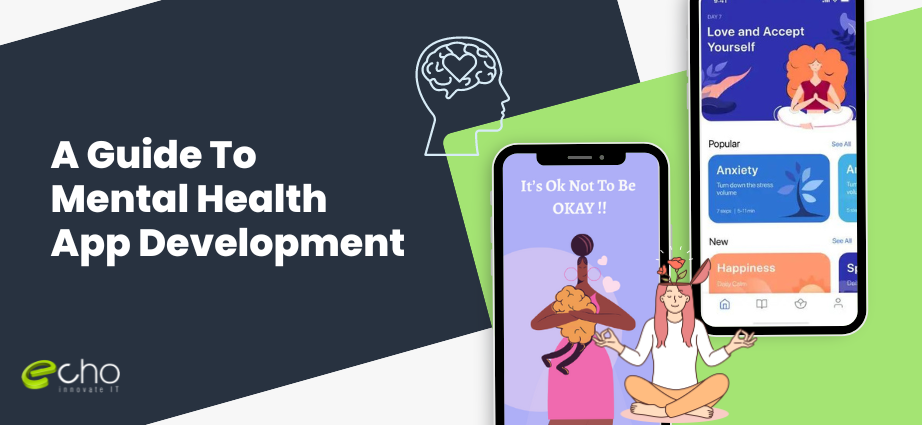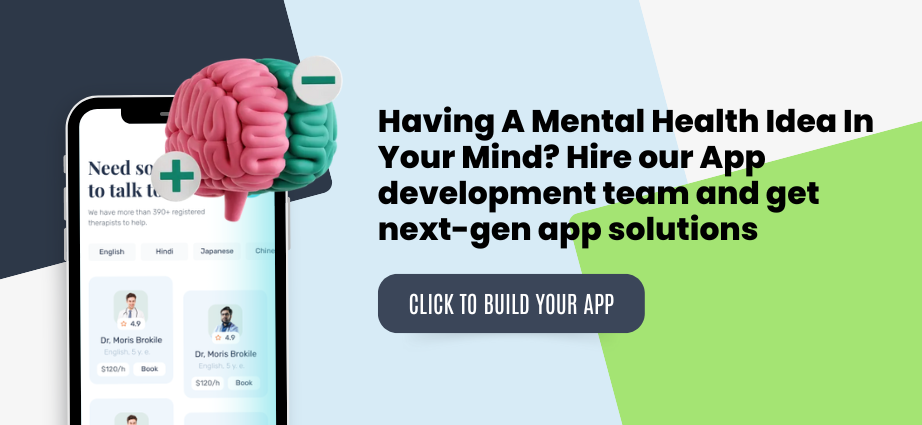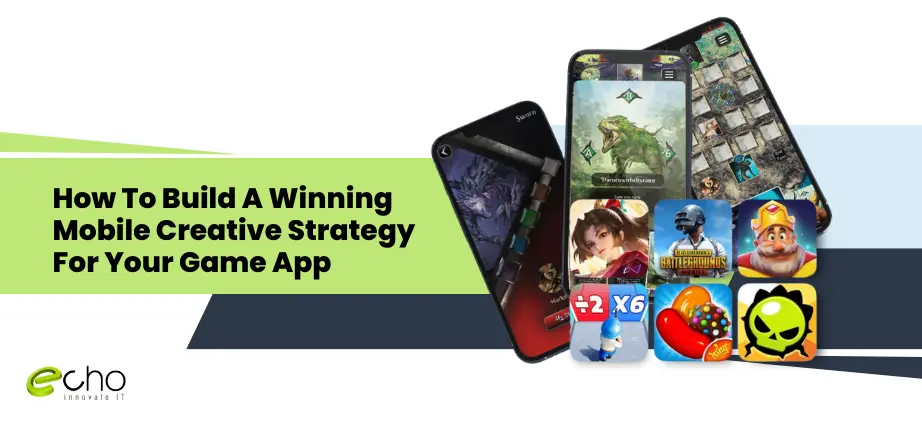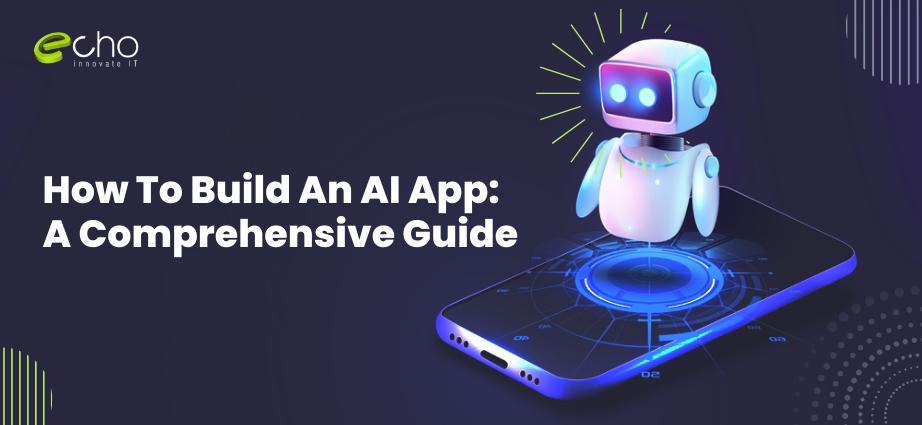Introduction
Have you been fascinated by mental health apps like Calm, MindDoc, Headspace and Wish to create one? By developing a mental health app, you can reach to large number of people suffering from stress, depression, and other psychological problems. Whether online therapy sessions, digital exercises for mindfulness and breathing, or chatting with mental health providers, these resources can come with a flexible schedule with 24/7 availability of healthcare providers.
Today’s blog will provide a detailed study on mental health development with cost, features, and required tech stacks. But before diving into the app development process, let’s briefly understand the meaning and current role of mental health apps in 2024.
Let’s Begin!
What Are Mental Health Applications
Mental health apps are mobile applications crafted to help users improve their emotional well-being, provide mindfulness and relaxation techniques for day-to-day stress, and deal with common psychological problems prevalent in the population today. There are different types of mental health apps designed for various purposes. Calm, Talkspace, Headspace, Happify, and Balance are some of the popular examples.
Thus you can choose any specific type of app helpful for depression, anxiety, mindfulness, stress relief, addiction, better sleep, positive thinking, etc. You can also create a multi-purpose application addressing various psychological issues by observing the current needs of the people today.
What Does The Mental Health Market Got To Say
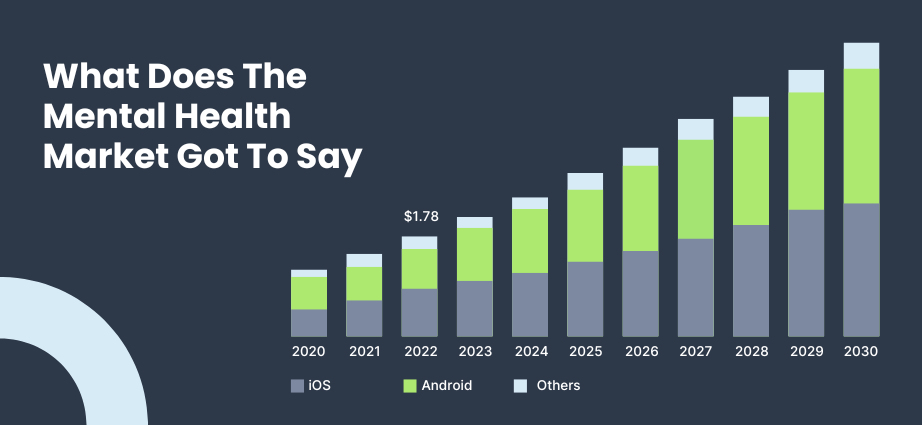
- The global mental health market is expected to reach $537.97 billion in 2030 growing with a CAGR of 15.3% from 2024 to 2030.
- The COVID-19 pandemic has brought an increased number of mental health cases as an estimated one-third of the world’s population is living in lockdown or quarantine. Isolation and reduced social support came hand in hand.
- Depression and anxiety dominate the mental health market and with this demand for digital mental health solutions is expanding day by day.
- According to the Business Research Company, the yearly growth rate of the mental health apps market was $7.18 billion in 2024 from $6.22 billion in 2023.
- Major trends integrated with mental health apps have been personalization and customization, integration of AI and machine learning, teletherapy, digital therapeutics, data security, and privacy compliance.
Types Of Mental Health Apps
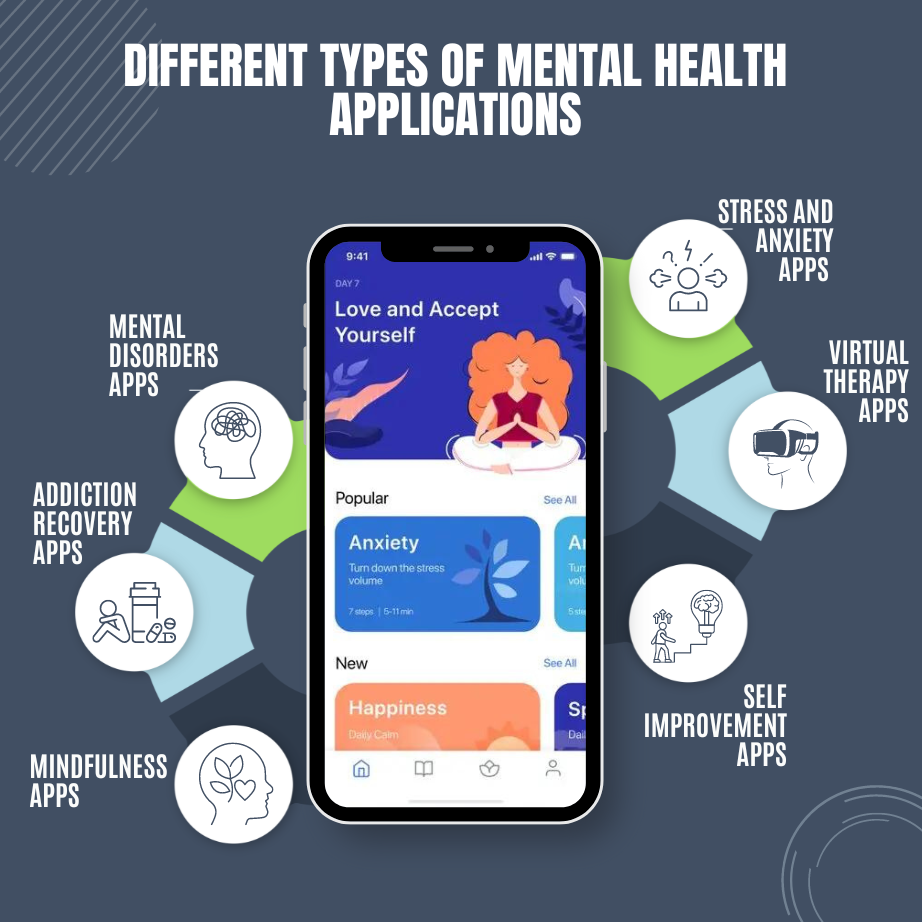
Mental Disorders Apps
These apps are designed for people living with disorders such as OCD or bipolar disorder. They can be used to control symptoms, care for oneself, and discover illnesses early. They use well-established therapeutic methods such as cognitive behavior therapy (CBT) and positive psychology to assist customers in diligently managing their mental health.
Journaling, mindfulness activities, and detecting worsening stages are among the features available. For people struggling with anger control, some apps include breathing exercises and provide instant access to contacts for immediate assistance.
Also Check:
Addiction Recovery Apps
These apps offer progress monitoring, motivational notifications, and relapse prevention capabilities. Users can establish goals, measure their progress, and receive motivating messages to stay on track. Peer support groups and round-the-clock live help are also critical components in preventing relapse.
Mindfulness Apps
Mindfulness apps are becoming increasingly popular as people’s lives become more hectic. Calm & Headspace provides a plethora of materials, such as meditation techniques, breathing exercises, relaxation tools, music, and calming bedtime stories. These apps address the requirements of those seeking to reduce stress, achieve mental clarity, and find peace amid chaos.
Self Improvement Apps
These apps can help those who are mentally healthy yet need to develop. These apps can assist people manage their mood swings, breaking harmful behaviors, aiding drug addicts to overcome abnormal conditions, and creating positive thinking. Anxiety control is another benefit of these apps.
Stress and Anxiety Apps
These apps help manage the symptoms of stress, anxiety, and depression targeting adults and adolescents for better mental health in everyday life. Such applications like Woebot provide you with CBT techniques, psychotherapy, behavior therapy, and mindfulness.
Virtual Therapy Apps
These applications typically feature programs for the treatment of a variety of health conditions. People who are suffering from mental health concerns may be afraid or embarrassed to seek professional help. As a result, virtual therapy apps serve as a form of salvation for them. Furthermore, these applications have been shown to produce good results.
Developing A Mental Health App: Step-by-Step Guide
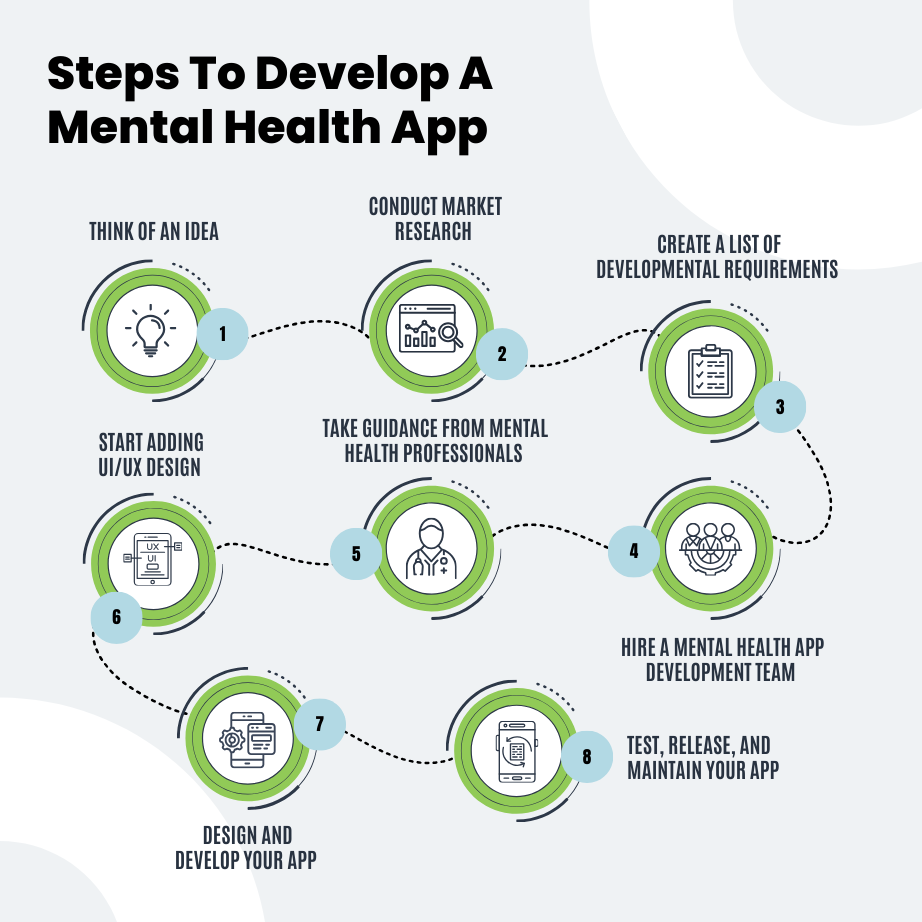
Step 1. Think of An Idea
Conduct market, competition, and target audience research to determine if your startup idea is viable, identify the appropriate market niche, and develop your unique value offer.
Step 2. Conduct Market Research
The next phase is market research. Examine what offerings are currently on the market and how popular they are. Read reviews of the most popular apps on the App Store and Google Play. Create a list of apps that you like and detest. Take note of their advantages and disadvantages. Divide apps by subject and determine which applications are in higher demand.
Step 3. Create A List of Developmental Requirements
Create a schematic of your users’ interactions with the mental health app to better understand their experience, identify potential anomalies in their trip, and optimize the user experience.
Step 4. Hire A Mental Health App Development Team
Hire a team of developers who can execute your digital mental health solutions. Do in-depth research on their portfolios, read reviews and clutch ratings, or check their expertise and years of experience.
Step 5. Take Guidance From Mental Health Professfessionals
If you want to create a practical application, you must enlist qualified professionals in the development process. You can speak with thought leaders in the mental health profession, read specialized literature, and attend presentations by well-known figures in mental health therapy.
You can also turn to Psychologists and Psychotherapists to understand and strategize effective treatment plans for the patients.
Step 6. Start Adding UI/UX Design
During the UI design stage, you must construct a design system or UI kit that includes all of your application’s visual elements (icons, buttons, input fields, fonts, colors, etc.). The UX Design stage is followed by the process of wireframing, prototyping, and testing phase
Step 7. Design And Develop Your App
Create a prototype to ensure that the app is easy to browse and that people understand how to use it. Also develop an MVP for iOS, Android, or both operating systems. If you want to save money, consider creating a React Native app that runs on both operating systems.
Step 8. Test, Release, And Maintain Your App
Launch your mental health app and work on continual improvement. To outperform competitors, you must maintain adequate app maintenance, give high-quality support to customers, and continuously enhance your app.
Also Check:
Tech Stack Required For Mental Health App Development
Here are the essential tech stacks that you need to add to your mental health application. Check out the table for reference:
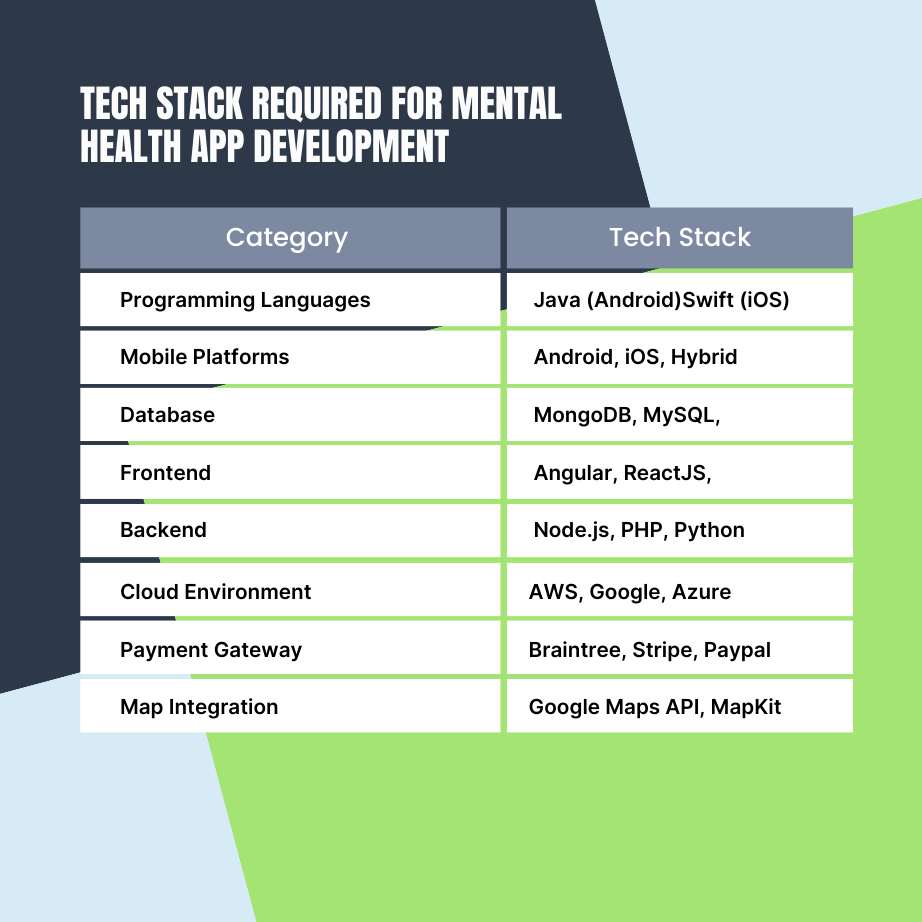
Must-Have Features In Your Mental Health App
Customer Profile
While a user profile may seem like a no-brainer, we mean that your application should seem personalized. The simplest method to accomplish this is to create a profile containing user details that influence how the app operates, such as “what time do you go to bed/wake up” or “how many times a week do you work out”.
Appointment Booking
Your solution should allow patients to schedule appointments with therapists. Ideally, the software will handle calendars that are native to the platform, such as Google Calendar or iCal. This also suggests the need for patient lists on the back end, as well as the ability to select and track therapy session lengths.
Notifications
Notifications and reminders help with the engagement difficulty that every mental therapy app must address: People should constantly use these goods to attain tangible outcomes. Patients can use them to keep track of their meals and prescriptions while also helping clinicians assess patient progress and stress levels.
Dashboards
People are getting increasingly preoccupied with quantifying themselves, and mental health is no exception. Dashboards are ideal for monitoring our cognitive, emotional, and other health problems.
Audio and Video Calls
Similar to messaging, audio and video calls are more significant in the context of telemedicine mental health apps. There are numerous factors to consider here, but if you can focus on one, it is how smooth these calls are. You want your users to have a 100% stutter-free experience during video sessions.
Cost And Time of Developing A Mental Health App
The cost and time of developing a mental health application depends upon various factors like app complexity and features, the company you are hiring, geographical location, development process, mobile app platforms, and tech stacks you are adding to your application. The average cost is between $15,000 to $70,000 and will take 3-6 months. However, there can be fluctuations in overall cost and timeline depending on the above factors we have mentioned.
Simple Steps To Monetize Your Mental Health App
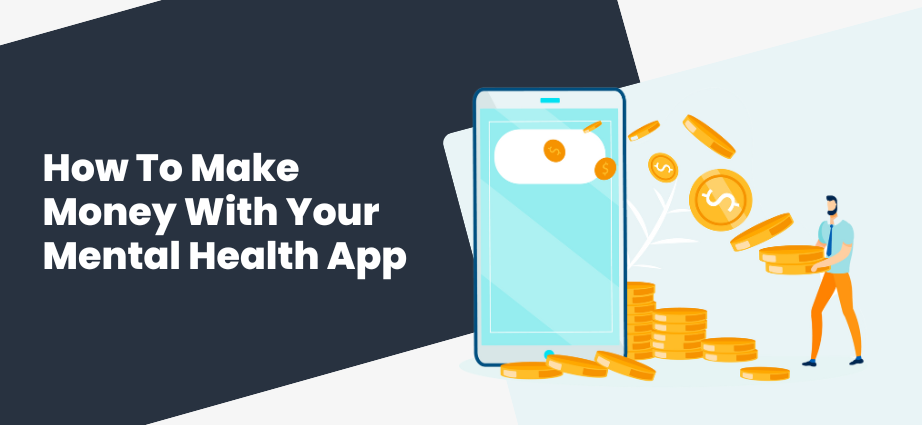
- Subscription-based Model: Registered users must pay to gain access to exclusive features or content. Typically, they are billed monthly or annually. It’s the most often used model for mental health applications.
- In-app Ads: Although this approach is less widespread, certain systems continue to use it. Ads are provided inside the mobile app in various formats, including banners, videos, and interstitials.
- Paid Sessions: Most counseling applications charge consumers for each hour of the session and deduct a commission fee before paying the counselor.
Conclusion
In today’s fast-paced world, we are continuously running in a loop of work-life balance, relationships, lifestyle, and personal hobbies. It is normal to find oneself stuck or getting affected by one parameter or another. This surely affects one’s psychological and emotional well-being leading to increased levels of stress and daily hassles. With this, the need for mental health awareness and digital solutions is of peak importance today. In short, investing in mental health apps in 2024 can be a profitable deal for startups and businesses. As such applications are widely used by people today.
Meet Your Development Team At Echoinnovate IT
Looking for a team that can turn your developmental goals into reality? Echoinnovate IT is a reputed App Development Firm that has been in service for more than ten years. If you are planning to invest in a mental health business, you are at the right place!
Hire our skilled developers and make your Mental Health App Development journey smooth and convenient. Tap the link below and reach out to our executive today.
FAQs- Mental Health App Development: A Comprehensive Guide
What are some key considerations for developing a mental health app?
Key considerations include understanding the target audience, incorporating privacy and security measures, designing intuitive user interfaces, integrating evidence-based mental health resources, and ensuring compliance with relevant regulations.
How can mental health apps promote user engagement?
Mental health apps can promote user engagement through personalization, gamification, community support features, regular updates, behavioral tracking, and educational content.
What steps can mental health app developers take to ensure inclusivity and accessibility?
Developers can ensure inclusivity and accessibility by designing with accessibility in mind, providing multiple language support, offering customization options, ensuring compatibility with assistive technologies, soliciting user feedback, and creating inclusive content.
